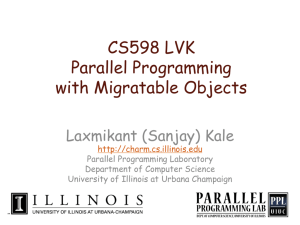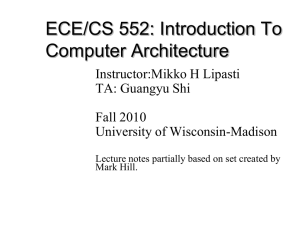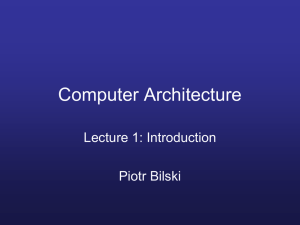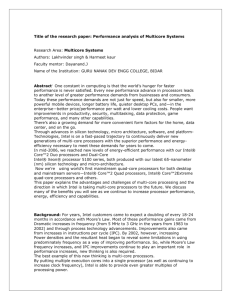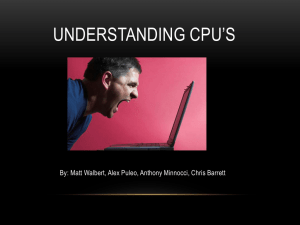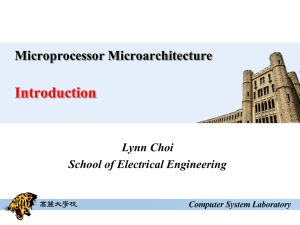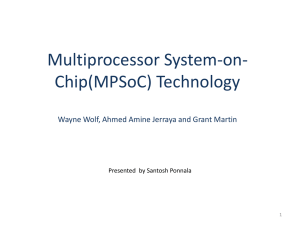overview
advertisement
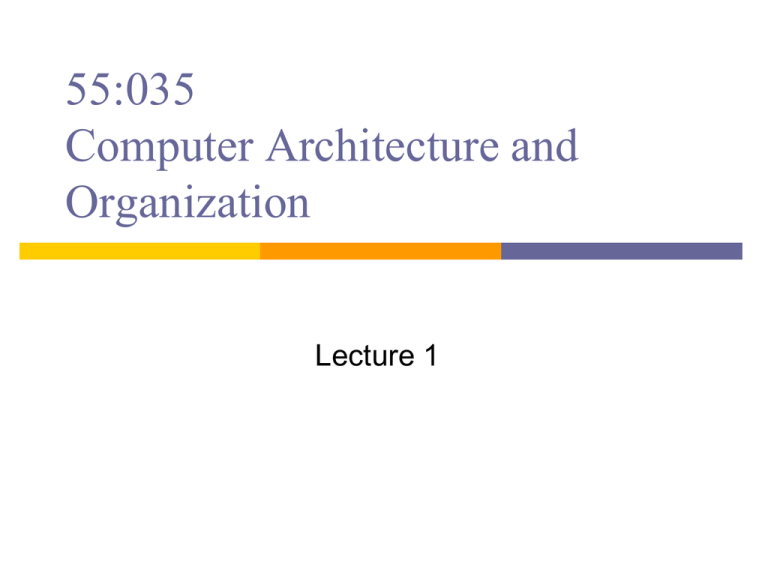
55:035 Computer Architecture and Organization Lecture 1 Introduction Introduction Description Course Outline Administrative Brief History of Computers Overview of Computer Organization Overview of Computer Performance Case Study: Intel Processors 55:035 Computer Architecture and Organization 2 Introduction Description from ISIS Basic concepts; computer evolution, register transfer level design, simulation techniques, instruction sets (CISC and RISC), assembly language programming, ALU design, arithmetic algorithms and realization of arithmetic functions, hardwired and microprogrammed control, memory hierarchies, virtual memory, cache memory, interrupts and DMA, input/output; introduction to high-performance techniques, pipelining, multiprocessing; introduction to hardware description languages (Verilog, VHDL); students design and simulate a simple processor. 55:035 Computer Architecture and Organization 3 Introduction Course Outline Introduction [chap 1] (2) Brief History Overview of Computer Organization Architecture: Instruction Set Design [chap 2] (6) Information representation & arithmetic operations Instruction Formats, Addressing Modes Assembly language Programming Basic input/output operations Subroutine linkage 55:035 Computer Architecture and Organization 4 Introduction Course Outline, cont’d Case Studies of Instruction Set Architecture [chap. 3] (4) Motorola M68000 ARM Intel Pentium Computer Arithmetic and ALU Design [chap. 6] (6) Addition (Subtraction) Multiplication (Division) Shifting and Rotating Floating Point Arithmetic 55:035 Computer Architecture and Organization 5 Introduction Course Outline, cont’d Verilog / VHDL Tutorials [Supplemental material] (6) Memory [chap 5] (6) Semiconductor Memory Technology Cache Memory Virtual Memory Memory Management and Case Studies 55:035 Computer Architecture and Organization 6 Introduction Course Outline, cont’d Processor Design [chap 7] (6) Input/Output [chap 4] (4) Datapath design Control Unit Design Microprogramming Exception Handling Device Interfacing and Addressing Interrupts Bus Design Additional topics [selected from chapters 8-12] 55:035 Computer Architecture and Organization 7 Administrative Lectures Instructor Time: M/W/F 8:30 - 9:20 AM Room: 4030 SC James Maxted: jmaxted@engineering.uiowa.edu Design engineer for Rockwell Collins (35 years) Office: 1126 SC, hours M/W/F 9:30 - 10:20 AM TA Dakai Jin: dakai-jin@uiowa.edu Office: 1313 SC, hours 55:035 Computer Architecture and Organization 8 Administrative (cont’d) Grading Approximately 1 homework per week 1 multi-part project 2 exams (1 mid-term, final) Weighting Homework 14% Project 36% Midterm 20% Final 30% 55:035 Computer Architecture and Organization 9 Administrative (cont’d) Course webpage Place to find syllabus, lecture notes, homework, etc http://www.engineering.uiowa.edu/~carch/ Project Design and simulate a simple processor Mentor Graphics tools VerilogHDL 55:035 Computer Architecture and Organization 10 Administrative (cont’d) Collaboration Discussion of the material is encouraged, but… All students are expected to do their own work Disabilities Please contact me (office hours or email) 55:035 Computer Architecture and Organization 11 Brief History of Computers Computing Aids Abacus and Counters Abacus: Greek for board or slab Probably originated in Middle East Invented 2000+ years ago Napier’s Rods (Bones) Assisted multiplication, square roots, and cube roots Invented around 1600 Chalk Board Interest Table Shows interest for varying principles and periods of time 55:035 Computer Architecture and Organization 12 Brief History of Computers Machines that Calculate or Control Adding machines Blaise Pascal’s “Pascaline” 1642 Automatic loom Punch cards used to control a manufacturing process 1800 Cash register “Incorruptible cashier” 1900 55:035 Computer Architecture and Organization 13 Brief History of Computers Electromechanical Devices Hollerith 1890 Census Tabulator Punch, tabulator and sorting box International Business Machines (IBM) Accounting Machines Changed circuits by moving cables in plugboards Early 1900s Ciphering and deciphering Encode and decode secret messages during World War II Enigma and Bombe 55:035 Computer Architecture and Organization 14 Brief History of Computers Electronic Computers Vacuum tube ENIAC: 17,000 tubes, 30 tons, 1800 ft2 1945 Transistor IBM System/360 Family Compatible processors, Standardized peripherals and connections 1962 Integrated circuit IBM PC Intel 8088 1981 55:035 Computer Architecture and Organization 15 Brief History of Computers The First Programmer Ada Augusta or Charles Babbage Robert Campbell, Richard Bloch, Grace Murray Hopper, or Howard Aiken 55:035 Computer Architecture and Organization 16 John von Neumann - IAS 55:035 Computer Architecture and Organization 17 von Neumann Architecture Sequential operation Automatic (without human intervention) Five elements: Input Output Memory Arithmetic Unit Control 55:035 Computer Architecture and Organization 18 Revised von Neumann Architecture 55:035 Computer Architecture and Organization 19 The Stored Program Concept Programming the Harvard Mark I was by external paper tape The ENIAC was “programmed” by rewiring it completely! 55:035 Computer Architecture and Organization 20 The First Business Computer LEO — Lyons Electronic Office — 1950 UNIVAC — Universal Automatic Computer — 1951 for the Census Bureau Modeled after the EDSAC Perhaps the first mass produced machine ERMA — Electronic Recording Means of Accounting —1957 for Bank of America 55:035 Computer Architecture and Organization 21 The First Bug 55:035 Computer Architecture and Organization 22 Basic functional units of a computer Arithmetic and logic Input Memory Output Control Processor I/O 55:035 Computer Architecture and Organization 23 Connections between the processor and the memory Memory MAR MDR Control PC R0 R1 Processor IR ALU R n- 1 n general purpose registers 55:035 Computer Architecture and Organization 24 Single-bus structure Input Output Memory 55:035 Computer Architecture and Organization Processor 25 Sharing the processor Printer Disk OS routines Program t 0 t1 t2 t3 55:035 Computer Architecture and Organization t4 Time t5 26 The processor cache Main memory Cache memory Processor Bus 55:035 Computer Architecture and Organization 27 Basic Performance Equation N S T R N is the actual number of instruction executions S is the average number of basic steps needed to execute one machine instruction R is the clock rate T is the processor time required to execute a program that has been prepared in some high-level language Instruction Sets: CISC and RISC RISC – Reduced Instruction Set Computers (smaller S likely leads to larger N) CISC – Complex Instruction Set Computers (larger S likely leads to smaller N) N S T R Performance Measurement System Performance Evaluation Corporation SPEC rating for a benchmark = Running time on the ethalon reference computer Running time on the computer under test n SPEC raiting SPECi i 1 1 n n is the number of the benchmarks programs in the suite Intel Processors: 4004 First microprocessor (1971) For Busicom calculator Characteristics 10 mm process 2300 transistors 400 – 800 kHz 4-bit word size 16-pin DIP package Masks hand cut from Rubylith Drawn with color pencils 1 metal, 1 poly (jumpers) Diagonal lines (!) 55:035 Computer Architecture and Organization 31 Intel Processors: 8008 8-bit follow-on (1972) Dumb terminals Characteristics 10 mm process 3500 transistors 500 – 800 kHz 8-bit word size 18-pin DIP package Note 8-bit datapaths Individual transistors visible 55:035 Computer Architecture and Organization 32 Intel Processors: 8080 16-bit address bus (1974) Used in Altair computer (early hobbyist PC) Characteristics 6 mm process 4500 transistors 2 MHz 8-bit word size 40-pin DIP package 55:035 Computer Architecture and Organization 33 Intel Processors: 8086 / 8088 16-bit processor (1978-9) IBM PC and PC XT Revolutionary products Introduced x86 ISA Characteristics 3 mm process 29k transistors 5-10 MHz 16-bit word size 40-pin DIP package Microcode ROM 55:035 Computer Architecture and Organization 34 Intel Processors: 80286 Virtual memory (1982) IBM PC AT Characteristics 1.5 mm process 134k transistors 6-12 MHz 16-bit word size 68-pin PGA Regular datapaths and ROMs Bitslices clearly visible 55:035 Computer Architecture and Organization 35 Intel Processors: 80386 32-bit processor (1985) Modern x86 ISA Characteristics 1.5-1 mm process 275k transistors 16-33 MHz 32-bit word size 100-pin PGA 32-bit datapath, microcode ROM, synthesized control 55:035 Computer Architecture and Organization 36 Intel Processors: 80486 Pipelining (1989) Floating point unit 8 KB cache Characteristics 1-0.6 mm process 1.2M transistors 25-100 MHz 32-bit word size 168-pin PGA Cache, Integer datapath, FPU, microcode, synthesized control 55:035 Computer Architecture and Organization 37 Intel Processors: Pentium Superscalar (1993) 2 instructions per cycle Separate 8KB I$ & D$ Characteristics 0.8-0.35 mm process 3.2M transistors 60-300 MHz 32-bit word size 296-pin PGA Caches, datapath, FPU, control 55:035 Computer Architecture and Organization 38 Intel Processors: Pentium Pro/II/III Dynamic execution (1995-9) 3 micro-ops / cycle Out of order execution 16-32 KB I$ & D$ Multimedia instructions PIII adds 256+ KB L2$ Characteristics 0.6-0.18 mm process 5.5M-28M transistors 166-1000 MHz 32-bit word size MCM / SECC 55:035 Computer Architecture and Organization 39 Intel Processors: Pentium 4 Deep pipeline (2001) Very fast clock 256-1024 KB L2$ Characteristics 180 – 90 nm process 42-125M transistors 1.4-3.4 GHz 32-bit word size 478-pin PGA Units start to become invisible on this scale 55:035 Computer Architecture and Organization 40 Intel Processors: Core 2 Duo 2006 Characteristics 65nm and 45nm 291 million transistors 2.5 GHz+ operation 32-bit word size LGA775 Dual core 14 stage pipeline Each gets L1 instruction and data caches Shared L2 cache Source: Intel 55:035 Computer Architecture and Organization 41 Transistors in Intel Processors 55:035 Computer Architecture and Organization 42 Clock Frequencies of Intel uP 55:035 Computer Architecture and Organization 43 Intel Summary 104 increase in transistor count, clock frequency over 30 years! 55:035 Computer Architecture and Organization 44 Clock Increases Have Slowed 55:035 Computer Architecture and Organization 45 Levels of Abstraction DEVICE RTL + A <= B + C; GATE TRANSISTOR S n+ PHYSICAL G D n+ Adapted from “Digital Integrated Circuits” copyright 2003 Prentice Hall/Pearson 55:035 Computer Architecture and Organization 46 Levels of Abstraction (cont’d) 55:035 Computer Architecture and Organization 47
